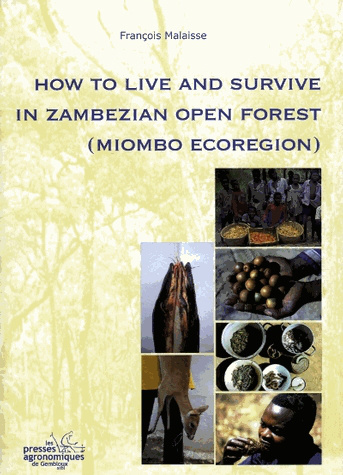How to live and survive in Zambezian open forest (Miombo ecoregion)
In the Miombo ecoregion (2,865,000 km² or 9.1% of Africa), the Zambezian open forest constitutes the main vegetation unit. It extends to no less than eight countries, from Burundi in the North to South Africa in the South, and from Angola in the West to Mozambique in the East. The austral part of Africa's open forests falls within the Zambezian Regional Center of Endemism outlined by White in 1983. This book focuses mainly on the wetter Zambezian Miombo woodlands. Also patches of mosaic Zambezian dry evergreen forests and small areas of grasslands on Kalahari sands are incorporated in the study.
The aim of this book is to gather together the amazing local environment knowledge of Zambezian open forests peoples in order to permit an easier improvement of their well-being. This research has been developed in an ethnoecological way of thinking. Indeed, the synergy arising from putting together local knowledge and updated ecological research provides huge information on ecosystem management, including biodiversity aspects. Ethnoecology is an emergent field that focuses on local peoples' perception and management of complex and co-evolved relationships between the cultural, ecological, and economic components of anthropogenic and natural ecosystems.
In the present book, the Zambezian wild edible products are treated according to fourteen items (from fungi, plants and honey, to beverages and salt, through mammals, birds, fish, insects and other animals). Some other comments concern agriculture and ethnoecology. All together more than a thousand edible products are involved; their ecology, their phenology, as well as their nutritional values are presented and discussed. The iconography is supported by a CD with 387 color photographs.
The earlier French version of 1997 has been reviewed and enlarged, taking into account recent progress of knowledge. An important bibliography is presented.
Professor François Malaisse has spent more than twenty years in Africa, and has carried out expertise in more than twenty African countries. He has been involved in research and teaching at Lubumbashi University in D.R.Congo and at several universities in Europe, notably Gembloux Agricultural University.
Spécifications
- Éditeur
- Les Presses agronomiques de Gembloux
- Auteur
- François Malaisse,
- Collection
- Agronomie
- Langue
- anglais
- Catégorie (éditeur)
- Sciences exactes > Biologie > Écologie et biogéographie
- Catégorie (éditeur)
- Sciences économiques et sociales > Sciences de la population et du développement > Étude du développement
- Catégorie (éditeur)
- Sciences appliquées > Agronomie et agriculture > Milieu et aménagement du territoire
- Catégorie (éditeur)
- Sciences appliquées > Agronomie et agriculture
- BISAC Subject Heading
- SCI026000 SCIENCE / Environmental Science
- Code publique Onix
- 06 Professionnel et académique
- CLIL (Version 2013-2019 )
- 3065 Sciences de la vie
- Date de première publication du titre
- 01 janvier 2010
- Type d'ouvrage
- Monographie
Livre broché
- Date de publication
- 01 octobre 2010
- ISBN-13
- 978-2-87016-106-7
- Ampleur
- Nombre de pages de contenu principal : 422
- Code interne
- 978-2-87016-106-7
- Prix
- 25,00 €
- ONIX XML
- Version 2.1, Version 3
Google Livres Aperçu
Publier un commentaire sur cet ouvrage
Sommaire
CONTENTS
Acknowledgements ................................................................................................... 7
Foreword .................................................................................................................. 11
Chapter 1 – Environment ........................................................................................ 15
Chapter 2 – Edible Wild Food ................................................................................ 41
2.1 – Fungi ........................................................................................ 41
2.2 – Plants ........................................................................................ 59
2.3 – Honey ....................................................................................... 99
2.4 – Great Mammals ....................................................................... 113
2.5 – Rodents .................................................................................. 125
2.6 – Birds ....................................................................................... 141
2.7 – Fish ......................................................................................... 165
2.8 – Reptiles .................................................................................. 197
2.9 – Caterpillars ............................................................................. 205
2.10 – Termites .................................................................................. 231
2.11 – Other Insects .......................................................................... 257
2.12 – Other Animals ........................................................................ 277
2.13 – Beverages ............................................................................... 287
2.14 – Salt ......................................................................................... 301
Chapter 3 – Ethnoecology ...................................................................................... 311
Chapter 4 – Agriculture ......................................................................................... 325
Chapter 5 – Synthesis and Discussion .................................................................. 333
Bibliography ......................................................................................................... 365
Appendixes on CD: 387 color pictures and two determination keys

